Analysis of plant growth-promoting properties of Bacillus amyloliquefaciens UCMB5113 using Arabidopsis thaliana as host plant
- PMID: 27541497
- PMCID: PMC5226999
- DOI: 10.1007/s00425-016-2580-9
Analysis of plant growth-promoting properties of Bacillus amyloliquefaciens UCMB5113 using Arabidopsis thaliana as host plant
Abstract
This study showed that Bacillus amyloliquefaciens UCMB5113 colonizing Arabidopsis roots changed root structure and promoted growth implying the usability of this strain as a novel tool to support sustainable crop production. Root architecture plays a crucial role for plants to ensure uptake of water, minerals and nutrients and to provide anchorage in the soil. The root is a dynamic structure with plastic growth and branching depending on the continuous integration of internal and environmental factors. The rhizosphere contains a complex microbiota, where some microbes can colonize plant roots and support growth and stress tolerance. Here, we report that the rhizobacterium Bacillus amyloliquefaciens subsp. plantarum UCMB5113 stimulated the growth of Arabidopsis thaliana Col-0 by increased lateral root outgrowth and elongation and root-hair formation, although primary root elongation was inhibited. In addition, the growth of the above ground tissues was stimulated by UCMB5113. Specific hormone reporter gene lines were tested which suggested a role for at least auxin and cytokinin signaling during rhizobacterial modulation of Arabidopsis root architecture. UCMB5113 produced cytokinins and indole-3-acetic acid, and the formation of the latter was stimulated by root exudates and tryptophan. The plant growth promotion effect by UCMB5113 did not appear to depend on jasmonic acid in contrast to the disease suppression effect in plants. UCMB5113 exudates inhibited primary root growth, while a semi-purified lipopeptide fraction did not and resulted in the overall growth promotion indicating an interplay of many different bacterial compounds that affect the root growth of the host plant. This study illustrates that beneficial microbes interact with plants in root development via classic and novel signals.
Keywords: Beneficial bacteria; Biocontrol; Growth promotion; Phytohormones; Rhizosphere; Root structure.
Conflict of interest statement
The authors declare that they have no competing interests.
Figures
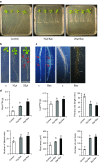
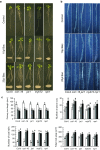


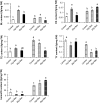
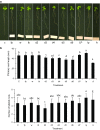
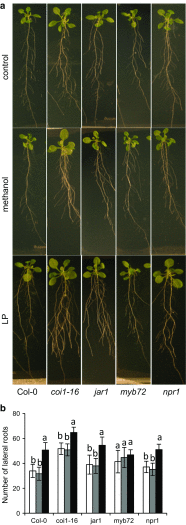
Similar articles
-
Insights into the molecular basis of biocontrol of Brassica pathogens by Bacillus amyloliquefaciens UCMB5113 lipopeptides.Ann Bot. 2017 Oct 17;120(4):551-562. doi: 10.1093/aob/mcx089. Ann Bot. 2017. PMID: 28961818 Free PMC article.
-
Genome analysis of Bacillus amyloliquefaciens Subsp. plantarum UCMB5113: a rhizobacterium that improves plant growth and stress management.PLoS One. 2014 Aug 13;9(8):e104651. doi: 10.1371/journal.pone.0104651. eCollection 2014. PLoS One. 2014. PMID: 25119988 Free PMC article.
-
Volatile compounds from beneficial rhizobacteria Bacillus spp. promote periodic lateral root development in Arabidopsis.Plant Cell Environ. 2021 May;44(5):1663-1678. doi: 10.1111/pce.14021. Epub 2021 Feb 18. Plant Cell Environ. 2021. PMID: 33548150
-
Gene Networks Involved in Hormonal Control of Root Development in Arabidopsis thaliana: A Framework for Studying Its Disturbance by Metal Stress.Int J Mol Sci. 2015 Aug 14;16(8):19195-224. doi: 10.3390/ijms160819195. Int J Mol Sci. 2015. PMID: 26287175 Free PMC article. Review.
-
Beneficial Microbes Affect Endogenous Mechanisms Controlling Root Development.Trends Plant Sci. 2016 Mar;21(3):218-229. doi: 10.1016/j.tplants.2016.01.013. Epub 2016 Feb 11. Trends Plant Sci. 2016. PMID: 26875056 Free PMC article. Review.
Cited by
-
Medicago truncatula root developmental changes by growth-promoting microbes isolated from Fabaceae, growing on organic farms, involve cell cycle changes and WOX5 gene expression.Planta. 2019 Nov 29;251(1):25. doi: 10.1007/s00425-019-03300-5. Planta. 2019. PMID: 31784832
-
Genetic, Epigenetic and Phenotypic Diversity of Four Bacillus velezensis Strains Used for Plant Protection or as Probiotics.Front Microbiol. 2019 Nov 15;10:2610. doi: 10.3389/fmicb.2019.02610. eCollection 2019. Front Microbiol. 2019. PMID: 31803155 Free PMC article.
-
Phytohormone Mediation of Interactions Between Plants and Non-Symbiotic Growth Promoting Bacteria Under Edaphic Stresses.Front Plant Sci. 2019 Oct 29;10:1368. doi: 10.3389/fpls.2019.01368. eCollection 2019. Front Plant Sci. 2019. PMID: 31737004 Free PMC article. Review.
-
Characterization of cadmium-resistant Klebsiella pneumoniae MCC 3091 promoted rice seedling growth by alleviating phytotoxicity of cadmium.Environ Sci Pollut Res Int. 2017 Nov;24(31):24419-24437. doi: 10.1007/s11356-017-0033-z. Epub 2017 Sep 11. Environ Sci Pollut Res Int. 2017. PMID: 28895046
-
Growth promotion on maize and whole-genome sequence analysis of Bacillus velezensis D103.Microbiol Spectr. 2024 Nov 7;12(12):e0114724. doi: 10.1128/spectrum.01147-24. Online ahead of print. Microbiol Spectr. 2024. PMID: 39508572 Free PMC article.
References
-
- Abd El-Daim IA, Bejai S, Meijer J. Improved heat stress tolerance of wheat seedlings by bacterial seed treatment. Plant Soil. 2014;379:337–350. doi: 10.1007/s11104-014-2063-3. - DOI
MeSH terms
Substances
LinkOut - more resources
Full Text Sources
Other Literature Sources

